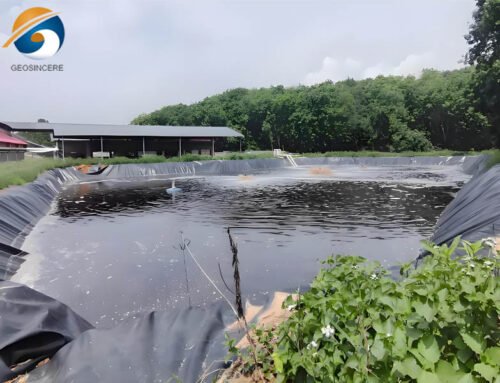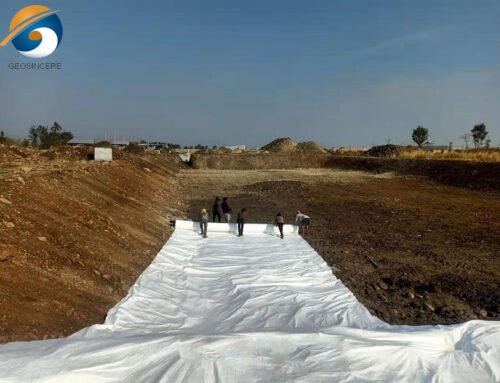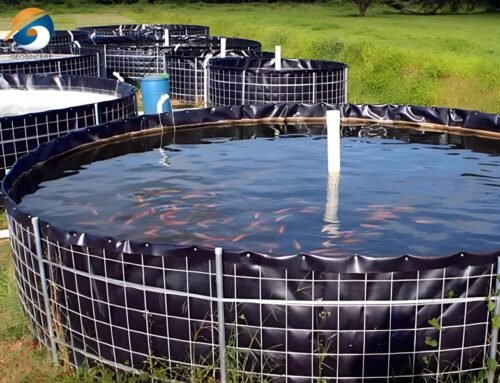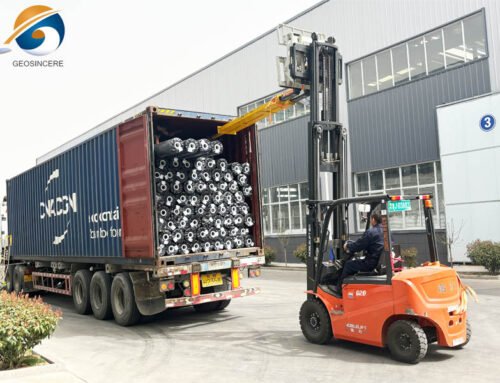Geomembrane welding vs adhesive seaming, which one is better for seaming procedure in geomembrane installation? As the geomembane manufacturer, we would like to make a brief introduction of this two kinds of welding method,together with its strength and drawbacks.
1 Brief Introduction to Geomembranes Seaming
Geomembrane seaming plays a crucial role in creating a complete waterproofing system for on-site projects. It is worth noting that, based on data, the seaming part accounts for approximately 80% of potential leakage points. Therefore, the seaming method employed holds significant importance. GEOSINCERE Geomembrane rolls, for example, can reach sizes of up to 8m x 210m or 8m x 420m, depending on the thickness, while on-site installation areas often exceed 500m or even 1000m. To ensure that each panel can be seamlessly bonded together, welding and seaming techniques are necessary.
In addition to considering the overall waterproofing system, the lifespan of the seaming is also a vital factor. Ideally, the seaming edge should have a similar lifespan to that of the mother geomembrane material. However, in reality, certain factors may affect this ideal scenario. It is essential to find ways to address and mitigate these factors to ensure the longevity and effectiveness of the seaming.
By addressing potential challenges and implementing appropriate solutions, the seaming process can contribute significantly to the overall performance and durability of the geomembrane system. Taking into account factors such as material quality, installation techniques, environmental conditions, and ongoing maintenance can help optimize the lifespan and effectiveness of the seaming, ultimately enhancing the overall performance and reliability of the waterproofing system.
2 Geomembrane Seaming Types
2.1 Geomembrane Welding Seaming
Automatic Welding for big range laying of HDPE Geomembrane Liner.
In this case will need Automatic HDPE geoemmbrane welding machine of GEOSINCERE800 and GEOSINCERE 900. GEOSINCERE-800 for geomembrane welding thickness 1.0mm and less thickness. And GEOSINCERE900 for geomembrane liner welding thickness more than 1.0mm as 1.5mm, 2.0mm, and more.


2.2 Hand Extrusion Weldinge Geomembrane
For small corners or T corners seaming of geomembrane liner, the hand extrusion welding technique can be employed. This method requires the use of specific equipment, such as GEOSINCERE1600A and GEOSINCERE610B, to achieve effective and reliable welds.
GEOSINCERE1600A is designed for welding geomembranes with a thickness of 1.0mm or less. It provides the necessary heat and pressure to melt and fuse the geomembrane material together, creating a strong and durable seam. This welding machine is suitable for thinner geomembranes commonly used in various applications.
On the other hand, GEOSINCERE610B is specifically designed for welding geomembranes with a thickness greater than 1.0mm, such as 1.5mm or 2.0mm. It offers the required heat and pressure to effectively bond thicker geomembrane materials, ensuring a secure and long-lasting seam.
By utilizing these specialized hand extrusion welding machines, the corners of the geomembrane liner can be seamlessly joined, providing a watertight and reliable connection. This technique allows for precise control and maneuverability, enabling welders to navigate small corners and T-shaped areas with ease.
It is important to follow the manufacturer’s guidelines and instructions for the proper use of GEOSINCERE1600A and GEOSINCERE610B welding machines. This ensures optimal performance, enhances the integrity of the seaming process, and contributes to the overall effectiveness of the geomembrane liner installation.
And the onsite for geomembrane liner welding will be need to proceeded by technicians with more than 3 years. GEOSINCERE provided installation services all more than 5 years to make sure the installation quality.
3. Geomembrane Seaming Procedures
3.1 Weather Considerations
Unfavorable weather conditions for panel installation encompass precipitation, standing water, high winds, or extreme temperatures. The optimal air temperature range for installation is between 40ºF and 90ºF. In cases of exceptionally warm or cold weather, it is advised to conduct frequent trial seams to ensure welders are appropriately configured for the prevailing conditions.
3.2 Methodology for Geomembrane Installation
The technique, workforce, and equipment employed during geomembrane installation must avoid causing harm to the membrane or the underlying subgrade surface. All installers are required to wear footwear that will not cause damage. Smoking or any activity with the potential to harm the geomembranes is strictly prohibited. If damage occurs, proper repair procedures must be promptly executed. Geomembranes should be positioned to minimize handling and allow sufficient slack to compensate for potential shrinkage.
3.3 General Requirements for Field Seaming
Various types of field welding equipment are available, with fusion welding and extrusion fillet welding machines being the most common. Sewing, taping, gluing, and solvent welding are not acceptable methods for field seaming unreinforced geomembranes. Extrusion welding machines are preferred for repairs, patching, and installing pipe boots.


3.4 Geomembrane Welding Seaming
Fusion Welding Machine. The fusion welding machine involves positioning a self-propelled hot wedge or hot air welder between two overlapping panel edges. These welders heat and melt the surface of the geomembrane, after which the material is compressed between two rollers. This combination of heat and pressure results in a fusion weld.
Extrusion Fillet Welding Machine. The extrusion fillet welding machine works by extruding a bead of molten resin along the edge of a panel overlapped on top of another panel. The molten resin induces the melting of each sheet, creating a homogeneous bonding of the panels. The polyethylene rod used for welding must be compatible with the liner material
3.4.1 Seaming Personnel
All personnel involved in seaming operations must undergo training on the specific equipment and seaming techniques recommended by the geomembrane manufacturer. A project foreman is responsible for supervising all personnel to ensure proper seaming procedures are adhered to.
3.4.2 Seaming Procedures
- Welders must be set up and adjusted according to the manufacturer’s requirements.
- Allow welders to reach the specified heat-up duration as outlined by the manufacturer.
- Extrusion fillet welders should be purged of degraded material before use.
- Monitor and maintain the proper edge overlap and operating temperature of the sealing apparatus during the seaming process.
- Ensure a minimum overlap of four (4) inches for standard welding and six (6) inches for extrusion fillet welding, or as specified by the welder manufacturer.
- Repair seal defects promptly, trim and patch any “fish mouths,” ensuring they are laid flat.
- Clean welding surfaces before initiating the process to guarantee the seam is free of moisture, dust, dirt, or any debris.
- For extrusion fillet welding, surfaces do not require abrasion (roughening). If abrasion is applied during cleaning, exercise caution to prevent material damage. If damage occurs, follow the appropriate repair technique.
3.4.3 Destructive Seam Testing
Conduct test runs of seams before commencing actual production to ensure correct equipment setup.
Perform these tests at least every five (5) clock hours, not operating hours.
Use liner pieces of sufficient length for welder temperatures to stabilize.
Follow the welder manufacturer’s recommendations.
Fusion welded seam samples should be a minimum of 10 feet long, and extrusion welded seams should be 3 feet long.
Cut test specimens from the end of the test seams.
Test seams must be conducted under the same conditions as the actual sealing process.
3.4.4 Peel Test Procedure
- Seam peel tests are primarily required in the field, unless otherwise specified.
- For unreinforced geomembranes, perform seam peel tests in accordance with ASTM D 6392, using the 90º T-peel method.
- Test five samples, one inch wide, pulled at a rate of 20 inches/minute using a field tensiometer.
- The failure must be a film tear bond (FTB).
- A passing sample may be considered if it does not fail within the stroke of the field tensiometer and elongates more than 50%.
- Acceptance criteria: 4 passing samples out of 5. If more specimens fail, the procedure shall be repeated with another set of samples.
- If the second set fails, the welding procedure will not be accepted until deficiencies are corrected and a passing seam is achieved.
3.4.5 Non-destructive Seam Testing
- 100% of field seams will undergo leak testing.
- Preferred test methods include vacuum box and air pressure testing.
3.4.6 Vacuum Test
- The vacuum box comprises a rigid housing with a clear viewing window, soft neoprene gasket, valve assembly, vacuum gauge, pressure-controlled vacuum pump, and a container of soapy solution.
- Vacuum box and procedures should comply with ASTM D-5641.


3.5 Adhesive Seaming in Geomembrane Installation
Adhesive seaming, often involving KS adhesive or adhesive tape, is typically applied in projects with smaller areas or when dealing with cutting holes in the geomembranes. Various scenarios, such as geomembrane-to-geomembranes, geomembrane-to-nonwoven geotextile, and non woven geotextile welding, require careful consideration for welding and seaming during the geomembrane installation process.
In the pursuit of establishing a robust waterproofing system and ensuring its successful completion, the quality of welding becomes paramount.
3.5.1 Advantages of Adhesive
Solving Small-Scale PE Geomembrane Welding-Addresses the challenge of welding small-sized PE geomembranes effectively.
Multi-Functional Application in geomembrane installation for self-adhesion and adhesion between geomembrane, geotextile, and concrete.
Repairing Damaged Geomembranes. When the geomembrane is damaged by sharp objects, the adhesive can effectively fix and strengthen the compromised area.
Adhering Geomembrane to Concrete. Functions as a bonding and waterproofing layer when adhering the geomembrane to concrete, enhancing the waterproofing capability. The adhesive’s substantial elongation accommodates base cracking and safeguards the geomembrane.
3.5.2 Adhesive Application Process
Heating and Melting. Heat the KS adhesive to a temperature of 180-220℃ until it melts into a liquid state.
Application with Metal Rod. Use a metal rod (solid, diameter 40mm) to apply the adhesive evenly, ensuring coverage without bumps, degumming, holes, loose sections, or dislocation.
Quality Assurance Check. Inspect the adherence for quality, checking for any imperfections.
3.5.3 Installation Guidelines
Optimal Heating Conditions. When heating the adhesive on-site, use a pot with a diameter of 20cm and maintain a moderate temperature to prevent smoking. Excessive heat may lead to thermal degradation, affecting adhesive properties.
Special Coating Tool. Choose a dedicated coating tool, such as a metal rod, for applying the adhesive evenly. Keep the rod in the hot adhesive during intervals.
Immediate Adherence. Adhere together immediately after coating, especially in colder weather. Limit coating lengths to 40cm at a time, and use a rubber hammer to reinforce the bonding surface for a tight seal.
Adhesive Tape Installation. For adhesive tape, installation is simplified, and placing it on the folding part is sufficient for effective adherence.
4. Conclusion
The choice between geomembrane welding vs adhesive seaming for geomembrane installation depends on the scale and specific requirements of the project.
For large areas, such as mining Tailings Storage Facilities (TSF) or landfills, welding seaming is recommended. Thorough testing of welding joints should be conducted to ensure the overall integrity of the project. Welding seaming is suitable for extensive systems that require long-term durability.
For small areas, adhesive seaming offers a cost-effective and easy installation alternative. It is particularly useful in projects where simplicity and cost efficiency are prioritized. Adhesive seaming is ideal for applications where welding seaming may be impractical or cost-prohibitive.
Ultimately, the choice between these seaming methods involves considering factors such as project scale, installation convenience, and long-term performance. By evaluating these factors, you can determine the most suitable seaming method for your specific geomembrane installation.





